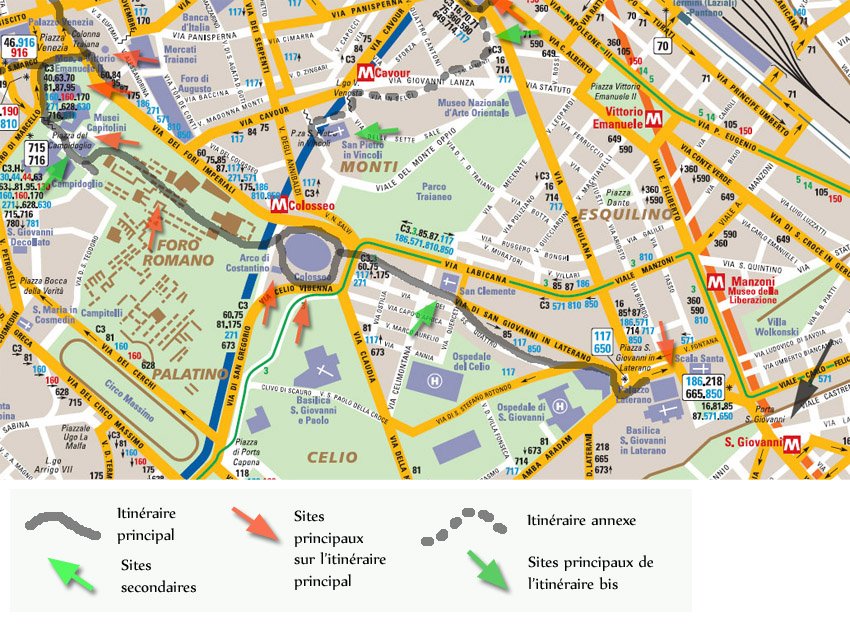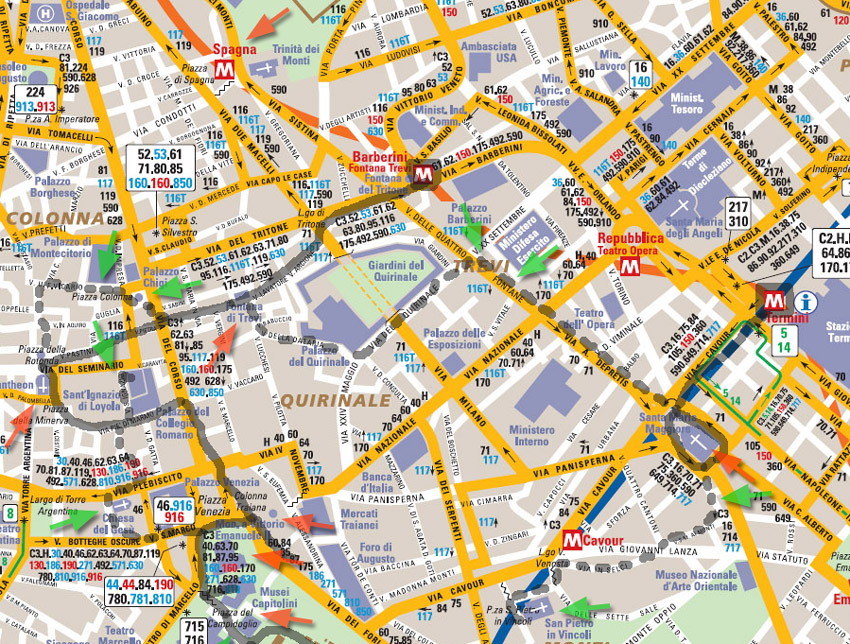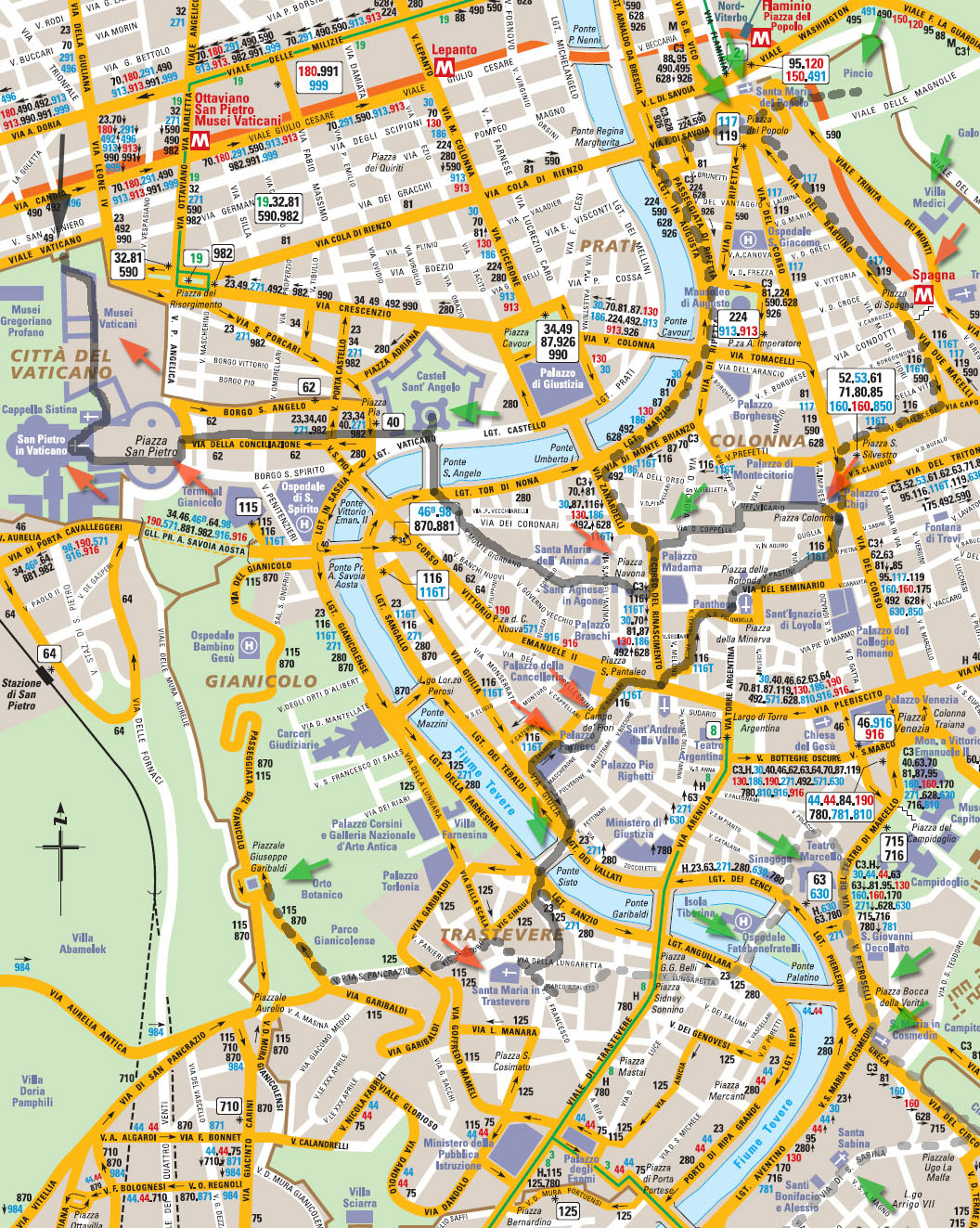TWO DAYS IN ROME
Proposed itinerary for two days in Rome
© rome-roma.net 2011
Rome was not made in one day, nor two. It is impossible to go around its main wonders in such a short time, and it is advisable not to seek to see everything.
We still offer here a very exhaustive tour, with an itinerary where you can ignore the so-called «secondary» sites (green on the maps) or which do not interest you. Moreover the itinerary of each of the two days can very well be done over two days. This is what we recommend ideally, to take the time to stroll and some surprise discoveries. Roman life is enjoyed to the rhythm of the Dolce vità, sitting on the terraces, enjoying ice cream, coffee or cappuccino 🙂
Day 1
Basilica of Saint John the Lateran and Saint Clement
We recommend starting your discovery of Rome with the Basilica of Saint John the Lateran, one of the four great Roman basilicas, which is also the Cathedral of the Pope as Bishop of Rome. You can admire the Gothic canopy and the cloister. Outside, there is the Scala Santa (the holy staircase), and the largest of the Egyptian obelisks in Rome.
Head west to take via dei SS. Coronati, and less than 300 meters away, is an austere but interesting Basilica of the Four Holy Crowned Ones. Further on, we reach the Basilica of Saint Clement, one of the most characteristic churches in the history of Rome, since it consists of three levels, each dating from an era of the city, the lowest is from the 1st century AD.
Colosseum and Roman Forum
Continuing along the street, you will arrive at the famous Colosseum. You can avoid the inner visit, for lack of time and for its moderate interest. Nearby, admire the majestic Arch of Constantine, from the 4th century, which includes elements from older Roman buildings.
The most interesting is the crossing of the Roman Forum which you can however follow by the Via dei Fori imperiali if you do not have the ticket. (The ticket is combined with the visit of the Colosseum, the Palatine and the Roman Forums).
Explore the forums, its remains and buildings that date back to the early days of the Roman Republic (-4th – 1st centuries), up to the Arch of Septimius Severus, which is the best preserved of the site. Exit towards Via dei Fori Imperiali and climb to the Capitoline Hill. On the other side of the hill, via Monte Tarpea is a beautiful viewpoint on the forums.
Capitolium and Piazza Venezia
This hill is where according to legend Rome was founded, by Romulus. Since the early days of the city, a huge temple dedicated to Jupiter crowned it, but it has long since disappeared.
The current Capitoline Square was designed in the 16th century by Michelangelo. In the center is a bronze equestrian statue of Marcus Aurelius (copy of the original). The palaces are home to the Town Hall of Rome and an important museum of Roman antiquities, the Capitoline Museums. Visit the museum if you are interested, it is with the National Roman Museum, the most important of the ancient museums of the city. Allow approximately 2 hours (minimum recommended).
While going down the monumental staircase, do not miss the statues of Castor and Pollux that frame the entrance to the Place, at the top of the staircase.
You will notice on your right another marble staircase that goes up to the church with the unfinished facade of Santa Maria in Aracoeli (it is also accessible by a secondary entrance from the top of the square) this one preserves a beautiful fresco of the Pinturicchio depicting the life of Saint Bernardine of Siena.
At the bottom of the stairs, you quickly arrive to the right at Piazza Venezia, one of the city’s transport hubs. The very imposing white monument, on the right, is the Monument to Victor Emmanuel II, built in the late nineteenth century inspired by the Great Altar of Pergamon, which you can take a look. Because of its mass crushing the other monuments, it never had the favor of the Romans who call it the «typewriter».
Imperial Forums
Cross the Via dei Fori Imperiali to the other side of the square, where you will reach the Imperial Forums, which you can spot by the ancient column that stands on its side.
The imposing avenue that joins the Colosseum, the Via dei Fori Imperiali, was the work of the Mussolini fascist era where little attention was paid to the important remains of the imperial forums that are today under the pavement.
The Trajan’s Forum, was the largest of the imperial forums of Rome. It remains in particular a substantial part of the markets and the famous carved Trajan’s Column, raised in the 2nd century AD to celebrate the victorious campaigns of the emperor Trajan against the Dacians (in present-day Romania).
Pantheon
Go to Piazza della Rotonda and the Pantheon, via del Corso. You can pass by the church of Gesù, the first Jesuit church in Rome, whose frescoes are admirable. Then, in the church of Sant’Ignazio di Loyola, the second Jesuit church in the city, also baroque, you can admire a trompe l’oeil dome that is actually a painting, as well as very beautiful frescoes by Andrea Pozzo.
The Pantheon, one of the best preserved ancient buildings in Rome, was a temple dedicated to the Roman gods. Today it preserves tombs including that of the first king of unified Italy, Victor Emmanuel II. On the pretty Piazza della Rotonda on which stands a beautiful baroque fountain with a small obelisk.
On the back right of the Pantheon is the Piazza della Minerva where a superb carved elephant of Bernini carries an obelisk. In this square you can visit the church of Santa Maria Sopra Minerva which is the only one in Rome that is Gothic (inside, the facade being Romanesque). It keeps before the choir a Christ carrying the cross of Michelangelo.
Path to the Trevi Fountain
We suggest you leave from the north to reach the Trevi Fountain. If you reach it by «Via degli Uffici del Vicario», you can enjoy a good ice cream at Giolletti.
Piazza di Montecitorio and Piazza Colonna are close to your route, we will suggest you visit them the next day, but you can do it today if the time is not too late (see paragraph (2), page 5)
Cross the Via del Corso (street dedicated to the clothing trade) to arrive at the Trevi Fountain, the most fantastic of Rome, baroque masterpiece immortalized by the Dolce Vità by Fellini.
Quirinal
Then take the direction of Piazza Barberini if you want to take transport to the Basilica of Santa Maria Maggiore, go to paragraph (3) below to see how.
We suggest otherwise, a path on foot, joining the elegant Piazza del Quirinale (seat of the presidency of the Italian republic). Then, in Via del Quirinale, Bernini participated in the realization of the church of Sant’Andrea al Quirinale, with its amazing dome surrounded by sculptures.
Further, at about 150 meters, you will cross the Via delle quatro fontane, where there is a fountain at each corner of the crossroads. Near an angle is the small church of San Carlo alle quatro fontane, a work of Borromini, the artistic rival of Bernini, with its harmonious vault.
Follow Via delle Quattro Fontane for 500 metres to the Basilica of Santa Maria Maggiore. Go to (4)
Papal Basilica of Saint Mary Major and Monti
(3)
You can reach the Basilica of Saint Mary Major in one of the following ways:
– You can take the metro A from Piazza Barberina to Termini station, then take the bus 105 for 1 stop getting off at Farini
– Take the 71 (STAZ.NE TIBURTINA (MB)), either on Via del Trafore, or towards the intersection of Via delle Quatro fontane, with Via Nazionale.
– By foot (following the dotted route on the map)
(4)
The Basilica of Saint Mary Major is perhaps the most impressive of the major basilicas after Saint Peter, having associated with the horns of time architectures and works of several eras.
Nearby, if you have time, visit the Basilica of Saint Praxedes (Santa Prassede), which preserves remarkable mosaics, then the Basilica of Saint Peter in Chains (San Pietro in Vincoli) in the neighborhood called «Monti». In the last one, is preserved the horned Michelangelo’s Moses statue, one of the most remarkable statues of the city.
If you have time, take the metro to the Spanish Steps.
The Monti district, whose heart is Piazza della Madona dei Monti between Piazza Venezia and Santa Maria Maggiore is a good place to spend the evening, have an aperitif and dine in one of the many trattorias or restaurants.
Day 2
Saint Peter’s basilica and Vatican City
To avoid waiting too long, we advise you to start by visiting the Vatican Museums and St Peter’s Basilica. You can avoid a too long wait by buying your ticket online in advance, choosing a time slot.
The museums are huge, the visit can hardly last less than two hours approximately. Its most remarkable places are the Sistine Chapel painted by Michelangelo and the Raphael’s Rooms are the most remarkable masterpieces.
After the visit of the basilica, where you will notice the remarkable canopy of Bernini and the Pietà of Michelangelo (just when entering on the right), enjoy the admirable St Peter’s Square, made by Bernini with its large double colonnade surmounted by statues of angels.
Then, by Via della Conciliazione, reach Castel Sant’Angelo, built around the circular Mausoleum of Hadrian. Cross the Tiber by the elegant Ponte Sant’Angelo bridge where the statues that represent episodes of the Passion of the Christ were also designed by Bernini.
Continue to Piazza Navona, one of the most magnificent squares in the city, for many the most beautiful. In the center the monumental Fountain of the Four Rivers was also a work designed by Bernini, with in the center a large Egyptian obelisk. The square has kept the shape of the ancient stadium of Domitian, some vestiges of which are visible on the north side, and others are under the cobblestones.
Spanish Steps
If you have already visited the Spanish Steps, go to paragraph (2) below.
If you have not visited the Spanish Steps the day before, we suggest you head there by going first to the Piazza del Popolo square, by one of the many buses that pass for example by the nearby Corso del Rinascimento.
The People’s Square stands out with in the center the statue of Valadier and its lions inspired by sphinxes between which stands another large Egyptian obelisk. On the west side the Basilica of Santa Maria del Popolo preserves many remarkable works (Caravaggio, Pinturicchio, etc). To the north of the square stands the Pincio hill. It is one of the most pleasant parks in the city with a beautiful view from its terrace on the square and the dome Saint-Pïerre.
Reach The Spanish Steps, doing a detour by Via Margutta for example, one of the nicest street in this area with artisan shops. The Piazza di Spagna is one of the most beautiful square in Rome and the most original with its unusual shape, the large monumental baroque staircases of Spanish Steps, climbing from the Fountain of Barcaccia to the church Trinità dei Monti preceded by an obelisk.
(2)
Pantheon district
Go to Piazza di Montecitorio. If you come from Piazza Navona you can reach it by Via Sant’Agostino. The homonymous church of Sant’Agostino preserves a beautiful painting of Caravaggio, as well as a small fresco attributed to Raphael.
The Piazza di Montecitorio is the seat of the Parliament, with opposite the obelisk that was found in the nineteenth century that served as a needle for a giant sundial under ancient Rome.
Just behind, going down, is Piazza Colonna. In this square, a column was built on the model of Trajan’s. It celebrates the victories of Marcus Aurelius, against the Germans and the Sarmates in the confines of the empire.
Campo dei Fiori and Piazza Farnese
If you miss the Pantheon, you can return there, on the way to Campo dei Fiori. In the morning, on the campo, a market is held, where fruits and vegetables, utensils, spices and flowers are sold. In the evening you will find the choice for a drink. The place is frequented by both tourists and Romans. In the center of the square is the suggestive statue of Giordano Bruno, a monk and philosopher with non-conformist ideas (he evoked the possibility of the existence of parallel worlds), which was burned in 1600 for heresy, on this same square, as was the case for many others. This symbol recalls the obscurantism – transient – of some religious who have abused their temporal power.
Via dei Baullari leads to Piazza Farnese. The beautiful palace is the seat of the French embassy. It was partly designed by Michelangelo (the top floor). On the square, the two large antique bathtubs, transformed into a fountain, come from the ancient Baths of Caracalla.
Trastevere
You can continue around the Farnese Palace by the right, joining the Via Giulia, one of the oldest streets of the city, one kilometer long, which you will follow from the left on a small part. You arrive at the elegant Ponte Sisto that you will cross to enter Trastevere district, through Piazza Trilusa. This district with character has many bars and trattorias, the choice of which extends to all budgets. Do not hesitate to visit Santa Maria in Trastevere, from the 12th century, which is located on the pretty square of the same name: Its interior is very pleasant, especially thanks to its Byzantine mosaics from the 13th century.
In the evening, you have the choice to have a drink in the neighbourhood, from the simplistic Bar San Callisto frequented by young and old from around the world, to the bobo and young bar Freni e Frezioni, adjacent to Piazza Trilusa.
If you have the possibility, and the energy, you can climb on the hill of Janiculum by taking the stairs of the Rampa di Monte Aureo, or by Via Garibaldi or via di Porta San Pancrazio. The climb, about 1,5 km, is quite rough, take the bus 115 if you prefer to go quietly.
From here you can enjoy a beautiful view of Rome. It is tradition, among the young Romans, to take their bride to kiss there at the beginning of the love parade …
If you need a taxi: Piazza Trilusa (near the Sisto bridge) or on Viale Trastevere.
In red, the main sites. In green, the sites «secondary» or to choose according to your tastes. Dotted, on the main route, the optional detour by bus to reach Piazza del Popolo. A side route is proposed at the bottom right.
TWO DAYS IN ROME
Proposed itinerary for two days in Rome
© rome-roma.net 2011











